Attracting Butterflies with Native Host Plants
This is the sixth in a series of articles written by Climate Action Coffee that seek to engage readers in the importance of pollinators and native plants. Today’s article focuses on planting native host plants to attract butterflies into your yard.
What is a host plant?
A host plant provides food for the larval or caterpillar stage of the butterfly/moth life cycle. Some plants and trees will host many different species but some are exclusive.
The Monarch Butterfly
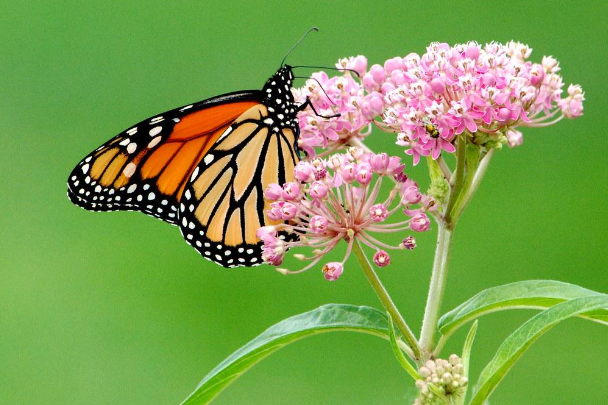
Most of us are familiar with the beautiful orange and black monarch butterfly. It lays its eggs–which hatch to become caterpillars–exclusively on milkweed plants (genus Asclepias).
These hungry caterpillars require milkweed leaves in order to survive. They then develop into a pupa or chrysalis, a cocoon where the butterfly continues to grow. The monarch butterfly caterpillar is notable for its alternating yellow, white and black stripes and you may see it munching away on milkweed leaves. Its chrysalis is bright green and hangs off of the milkweed stems until the butterfly hatches and flies away.
The milkweed species include the common milkweed, red milkweed, showy milkweed, Sullivant’s milkweed and butterfly weed (not butterfly bush). Milkweed contains a toxic substance that only monarch butterflies can tolerate. This substance transfers into the monarch’s body, which in turn protects it from predators.
Baltimore Checkerspot
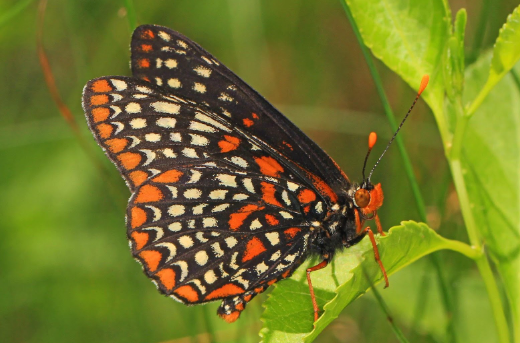
Many may not be aware that the Baltimore checkerspot is the Maryland State butterfly. Like the monarch and the viceroy, it too is orange and black but with a distinctively different pattern. It is rare to see this beauty but if you cultivate its host plants, the white turtle head and hairy penstemon, you may get a chance. Its caterpillar has orange and black stripes with black hairy ridges and its beautiful chrysalis is mostly white with a pattern of black and orange spots.
Eastern Tiger Swallowtail
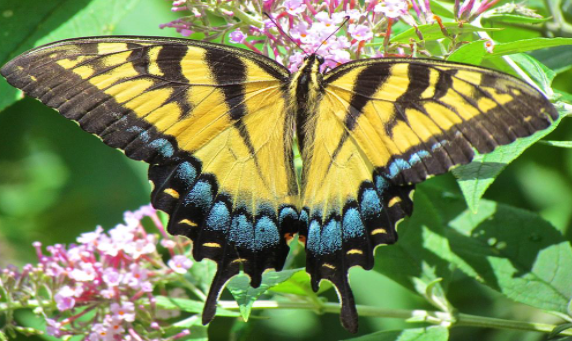
The tulip tree or tulip poplar is the tallest hardwood tree in North America. Its bright orange, yellow and green cuplike flowers resemble the tulips for which it is named. It is a favorite nesting tree for birds, notably the Baltimore oriole. It hosts the Eastern tiger swallowtail and the promethea silkmoth as well as other species of moths. Other host plants for the Eastern tiger swallowtail are ash, wild black cherry and the sweet bay magnolia. This pretty yellow butterfly with black striped markings and a bit of blue on its tail starts out as a pale green caterpillar with a large brighter green round head and yellow eyes. Its chrysalis could easily be mistaken for a dead brown leaf.
Because many butterflies and moths overwinter in our garden debris, such as leaves, grass, etc., use a light touch when cleaning up your garden in the fall. These insects blend in well with dead plant material, often mistaken for a dead brown leaf. Leave areas under the trees and shrubs intact to provide habitat for hibernating insects. This will ensure their survival and their presence in your garden the following year.
Luna Moth
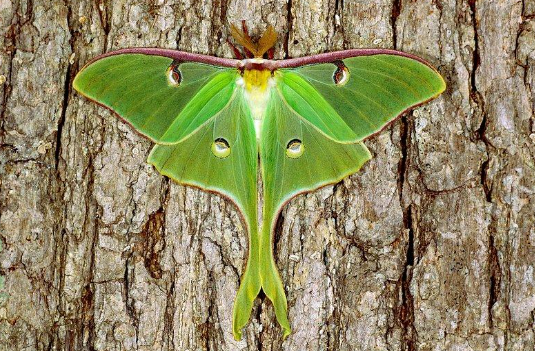
The large and beautiful luna moth, with its lime green wings edged in purple and a distinctive long twisted tail, is nocturnal. Its caterpillar is a matching light green on top with a darker green underside. The cocoon is dark brown which easily blends in with plant debris and leaves. It has a wingspan of 4.5 inches and in rare instances, 7 inches. Its large body is approximately one inch long. It has notable forewings with eye spots and hindwings. To attract these beauties, plant white birch, American persimmon, American sweet gum, or species of hickory, walnut and sumac.
The Orange Sulphur
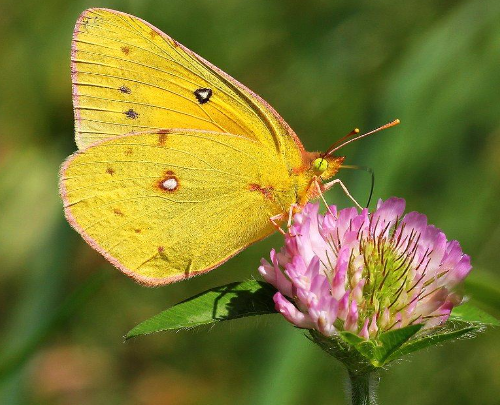
The orange sulphur is a widespread and common butterfly whose caterpillars feed on pea family plants like vetch and clover. Vetch is native to the U.S. and has special value to native bee species. While clover is being promoted as an alternative to turf grass and to attract pollinators, white clover is not native to the U.S. Be sure to use native clovers if you are planting clover to replace your lawn. Adult orange sulphurs rely on nectar from a variety of flowering species including milkweeds and plants in the Asteraceae family including condflowers, sunflowers, and asters.
The Viceroy
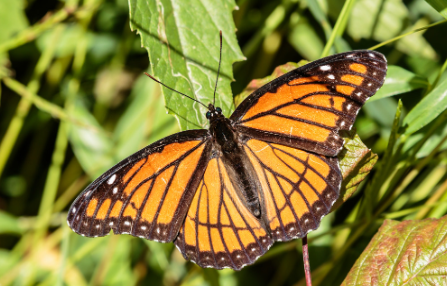
Viceroy butterflies look a lot like monarchs–the coloring and pattern of their wings are nearly identical. But if you look closely, a viceroy has a black line that runs across the veins of its hindwing. In addition, viceroys are smaller than monarchs. Both the monarch and the viceroy are noxious-tasting to their common predators–a phenomenon known as Mullerian mimicry where different species share (mimic) the same warning signs to ward off common predators.
As caterpillars, they feed on poplar and willow leaves as well as wild plum. The viceroy butterfly eats the nectar of flowers from the Asteraceae family that includes goldenrod, thistles, asters, and other common flowers.
American Lady
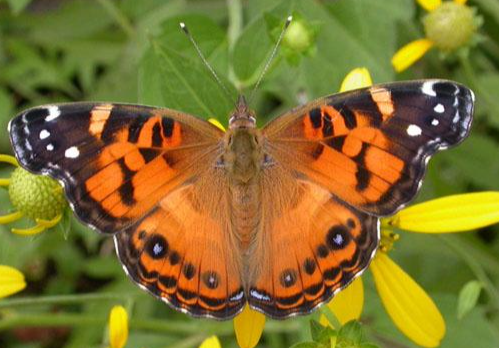
The American lady is an attractive butterfly that occurs throughout the US, but is best known among naturalists for the characteristic nests made by its caterpillars. Larvae make nests at the tops of host plants by silking together leaves and chaff at the tips of the flower stalks where they hide during the daytime and come out at night and on overcast days to feed. Pussytoes are a native, low-growing ground cover that host the American lady.
Pearl Crescent
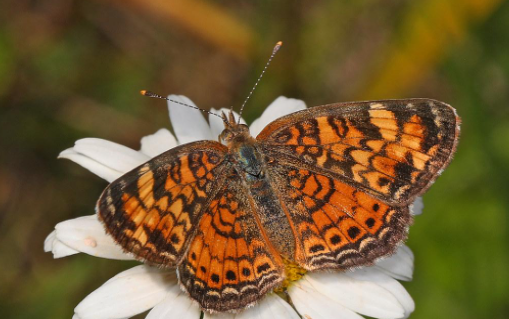
The pearl crescent is a common butterfly in Maryland, which is named for a crescent-shaped spot on the underside of the hindwing. The eggs are laid in small batches on the leaves of host plants in the aster species (family Asteraceae), and caterpillars eat these leaves. To attract and nurture pearl crescents in your yard, plant white panicle aster, hairy white oldfield aster or smooth blue aster.
The Zebra Striped Swallowtail
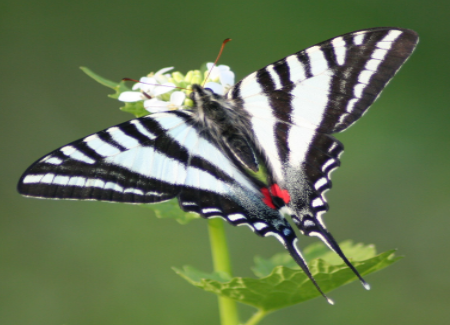
The zebra striped swallowtail can be quite common in places where its host plant, the pawpaw, is abundant. Its larva is a bright green and it matures into a brown pupa or chrysalis. The American paw paw is a small deciduous understory tree that bears a yellow-green to brown fruit, the largest indigenous fruit in North America. The pawpaw grows in a temperate climate with a wide range and it is a member of a tropical family, the Magnoliates. Its fruit is sweet with a custard-like texture and a flavor similar to banana, mango, or pineapple. It has a long tap root and is typically found along the slopes of flood plains and shady, rich bottomlands. They are commonly seen along the C & O Canal in Maryland where they grow in patches. Its small dark maroon flower is pollinated by beetles or the dung fly, requiring pollen from a tree outside of its clonal patch to germinate.
Marguerite Cyr and Maureen Malloy, 8/24
Climate Action Coffee (CAC) – Takoma Park Mobilization

